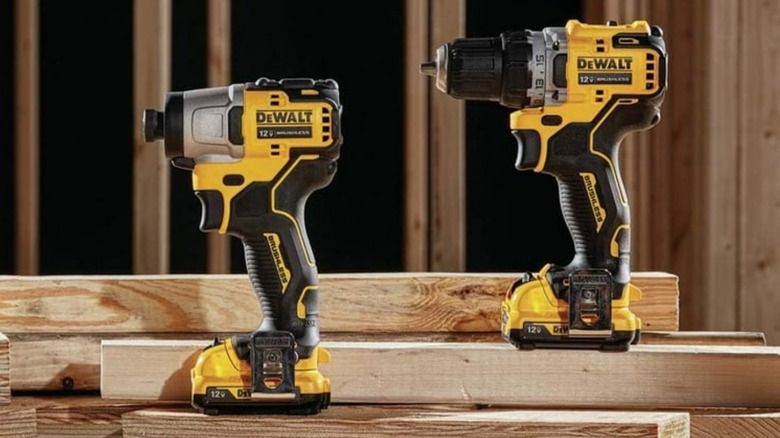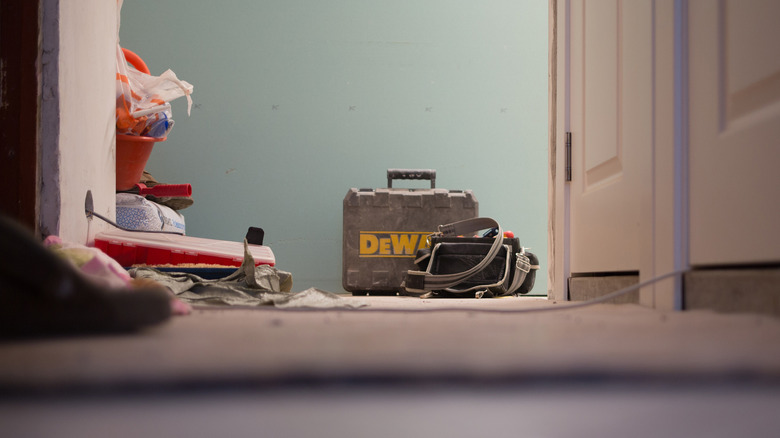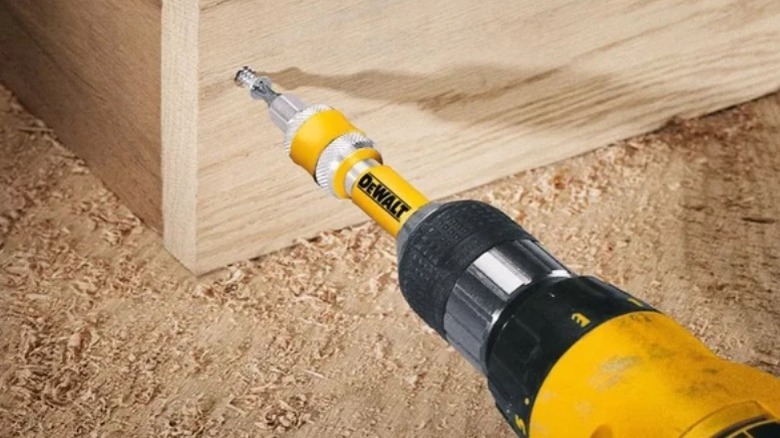Here's When You Should Use Your DeWalt Drill Instead Of An Impact Driver
We may receive a commission on purchases made from links.
All of the standard drill/drivers that DeWalt makes can be counted among the most useful and versatile tools that you can add to your collection. The variable speed trigger and adjustable chuck that come standard on all of the company's modern drills make them jack-of-all-trades tools that can handle the vast majority of your rotary needs. They can hold drill bits, driving bits, and a whole host of other useful extensions that have nothing to do with drilling whatsoever. That said, there are a few other specialty rotary tools that might be more useful or convenient in certain circumstances.
The impact driver is one such tool. You may have noticed that DeWalt often sells its drill and impact driver models together in a bundle, and there are a few great reasons why you might want both. The impact driver is typically lighter, more compact, and easier to maneuver. It usually has more torque and utilizes a quick-change hex clamp that allows you to quickly switch out any ¼-inch hexagonal bits. This makes it a much more useful tool for times when you might need to drive through denser materials, or many situations when you might need to put a lot of fasteners in very quickly, such as when assembling a deck or a fence. Additionally, having both tools makes it easy to drill pilot holes with one and drive fasteners with the other, so you don't need to swap out bits every few seconds.
But as useful as it is to have an impact driver in your arsenal, there are several situations where you might be better off sticking with the standard drill. DeWalt's drills are better suited to driving fasteners through softer materials as well as precision work that requires a little bit more control.
DeWalt's regular drill is better for softer materials
DeWalt's impact drivers are powerful tools that are designed for strength and speed. But this very quality that makes them great for rapidly building a shed or installing flooring makes them less than ideal for use on softer materials.
One of the biggest examples of this is drywall. When installing drywall panels, you'll typically want to use a standard drill, which you would ideally pair with a screw setter bit. These have a collar around the actual fastener bit that is designed to prevent you from over-driving the screws. But whether you have the screw setter bit or not, DeWalt's impact drivers are far too powerful for this delicate material. Any of them can easily punch the screws straight through the drywall to the joist. Other materials can suffer from this, too. MDF and softer plywoods, such as the materials often used in the construction of box store furniture, can easily crumble from the force of a rapidly spinning screw. This strips the material from the pilot hole, preventing the screw from getting a strong bite.
There are a couple of reasons why DeWalt's standard drills are a better option. The first is speed control. In addition to having a variable speed trigger for reactive control, all of DeWalt's drill drivers have multiple gears that allow you to set the RPM range, so you can dial it down for more delicate tasks. The second reason is that DeWalt's drills have a clutch that allows you to set how much force the drill can exert before it disengages. This can help you dial in the exact amount of rotational force you want to implement to prevent stripping screws, threading holes, and accidental over-driving. Impact drivers don't usually offer these features.
DeWalt's regular drill offers more control
There are a lot of construction-oriented tasks where you can get away with ramming self-piloting screws into unfinished boards, sinking them a bit below the surface, and then calling it good, but more precision-oriented woodworking tasks might benefit from a gentler touch. Those who are building furniture, or other, more delicate pieces, might prefer to stick with their basic drill for driving their fasteners.
There are a lot of situations where you might be attempting to thread a screw into a narrow piece of adjoining wood. Keeping the fastener perfectly straight and applying even pressure is paramount to ensuring that the joint comes together smoothly. Those seeking to sink the screw below the surface may even wish to use a countersink bit so that the screwhead doesn't exert too much pressure on the surface of the piece. Using an impact driver in these situations is an invitation to sacrifice accuracy in the best cases, but it's also possible that it might damage the wood you're attempting to join.
Impact drivers apply a lot of force, and this can sometimes cause wood to split if it isn't properly piloted or if the fastener is driven too deeply. In instances where the force of the screwdriver exceeds the strength of the fibers binding the board, they will come apart. This is one of the many reasons why the most delicate projects, such as boxes and picture frames, rarely call for the use of screws at all. Even hardwoods that might not easily strip can still split if they are hit with too much force, particularly when you are driving fasteners near the edge of a board.


